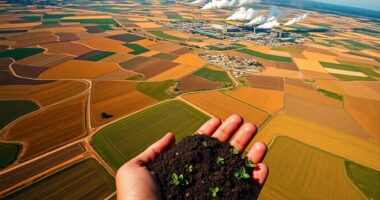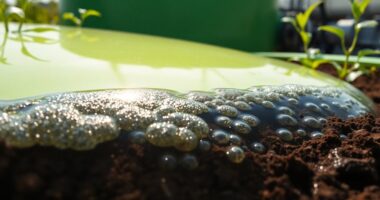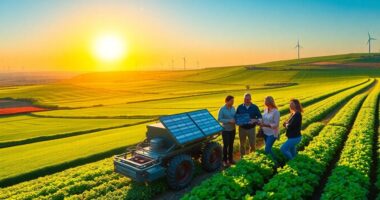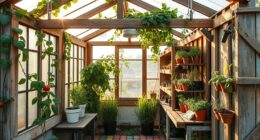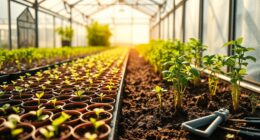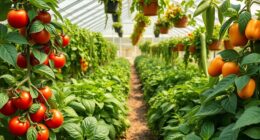To conserve every drop in your greenhouse, start by harvesting rainwater through gutters and storing it safely. Use soil moisture sensors and mulch to prevent overwatering, and implement drip or automated irrigation systems for targeted, efficient watering. Combining these techniques helps reduce water waste, lowers utility bills, and supports healthier plants. By adopting water-wise practices, you’ll create a sustainable environment—continue to explore how you can optimize your greenhouse’s water management for long-term success.
Key Takeaways
- Collect rainwater through gutters and store in sealed tanks to reduce reliance on municipal water.
- Use soil moisture meters and mulch to maintain optimal soil moisture and minimize unnecessary watering.
- Implement targeted drip irrigation systems for efficient water delivery directly to plant roots.
- Incorporate automated, smart watering systems to optimize schedules and prevent water waste.
- Regularly maintain rainwater harvesting and irrigation systems to ensure maximum efficiency and water quality.
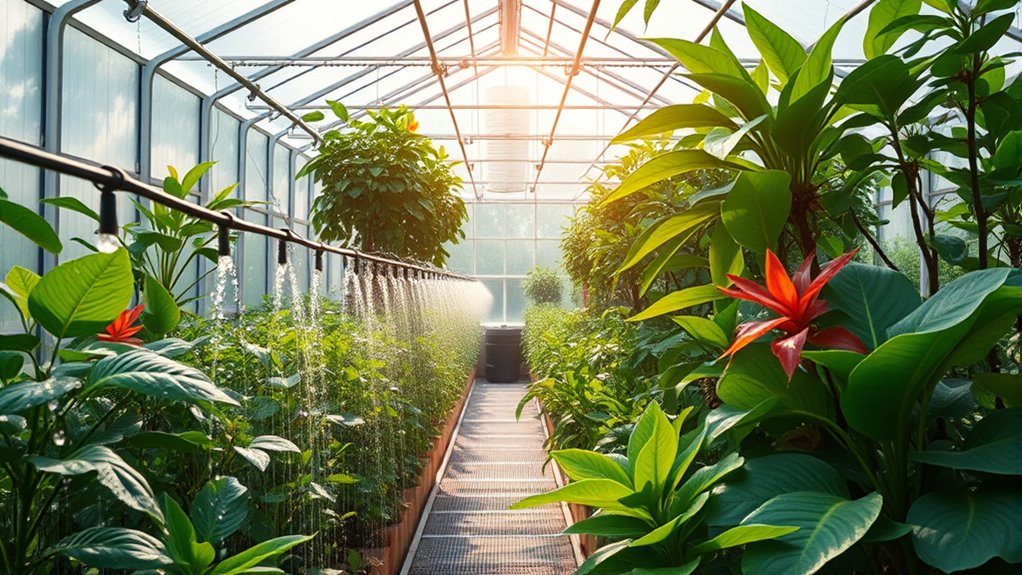
Growing plants in a greenhouse doesn’t have to waste water. In fact, implementing smart water management techniques can markedly reduce your overall consumption while maintaining healthy, thriving plants. One effective method is rainwater harvesting. By collecting rainwater from your greenhouse roof and directing it into storage barrels or tanks, you create a sustainable source of irrigation water. This not only lessens your reliance on municipal water supplies but also prevents runoff that can carry pollutants into local waterways. Rainwater is naturally soft and free of chemicals like chlorine and fluoride, making it ideal for most plants. Plus, harvesting rainwater is straightforward: install gutters along your greenhouse roof, connect downspouts to storage containers, and ensure your system is covered to prevent mosquito breeding. Regularly harvesting rainwater means you always have access to fresh, chemical-free water, especially during dry periods.
Alongside rainwater harvesting, soil moisture management plays an essential role in conserving water within your greenhouse. Instead of frequent, shallow watering, focus on maintaining proper soil moisture levels that encourage deep root growth. Use a soil moisture meter or simply check the soil’s dampness to determine when watering is necessary. When you water only when the soil starts to dry, you reduce unnecessary runoff and evaporation, ensuring every drop counts. Mulching around plants helps retain soil moisture, keeping it consistent and reducing the need for additional watering. Organic mulches like straw, wood chips, or compost also improve soil health over time. Additionally, consider installing drip irrigation systems that deliver water directly to the roots with minimal waste. These systems can be automated, guaranteeing your plants get the right amount of water precisely when they need it, further preventing overwatering. Incorporating water-efficient irrigation techniques can greatly enhance your water conservation efforts.
Combining rainwater harvesting with diligent soil moisture management creates a sustainable cycle. You collect ample rainwater during wet seasons, which you then use efficiently through targeted watering methods. This synergy not only conserves water but also promotes healthier plant growth, reduces your utility bills, and minimizes environmental impact. Remember, the key is to be attentive and proactive—monitor your soil regularly, adjust your watering schedule accordingly, and make sure your rainwater harvesting system is functioning correctly. Incorporating high-efficiency watering techniques can further optimize water use and reduce waste. Being aware of lifestyle habits that impact water usage can help you develop more sustainable routines, both inside and outside your greenhouse. Additionally, educating yourself about water conservation practices can further enhance your efforts. Utilizing smart watering systems can help automate and optimize your watering schedules for maximum efficiency, conserving even more water. With these techniques, you’ll become a water-wise greenhouse gardener, making every drop count and ensuring your plants thrive without unnecessary waste.
Frequently Asked Questions
How Can I Measure Water Efficiency in My Greenhouse?
To measure water efficiency in your greenhouse, start by tracking your water usage over time. Use drip irrigation systems to deliver water directly to plants, minimizing waste. Incorporate moisture sensors to monitor soil moisture levels, ensuring you’re not overwatering. Compare the amount of water used with plant health and yield data. Regularly assess these metrics to optimize your watering practices, making your greenhouse more water-efficient and sustainable.
What Are the Best Drought-Resistant Plants for Greenhouses?
You should choose drought-resistant plants like native succulents and xeriscape plants for your greenhouse. These plants thrive with minimal water, making them perfect for water-wise gardening. They’re adapted to dry conditions, so you won’t need to water frequently or worry about overwatering. Incorporating native succulents and xeriscape plants not only conserves water but also adds unique textures and colors to your greenhouse landscape.
How Does Soil Type Affect Water Conservation Efforts?
Soil type plays a vital role in your water conservation efforts. Well-draining soil prevents waterlogging, reducing excess water use and runoff. Conversely, soil with good nutrient retention helps your plants stay healthy with less frequent watering, saving water. By choosing the right soil, you optimize drainage and nutrient retention, making your greenhouse more efficient and sustainable. This approach guarantees you use water wisely while keeping your plants thriving.
Can Automated Watering Systems Save More Water?
Automated watering systems can save more water when you incorporate smart sensor integration and rainwater harvesting. By using sensors, you guarantee watering only occurs when plants need it, reducing waste. Rainwater harvesting provides a sustainable source, further cutting down on tap water use. Together, these techniques optimize your watering schedule, conserve water, and promote healthier plants, making your greenhouse more efficient and environmentally friendly.
What Are the Signs of Overwatering in Greenhouse Plants?
Think of overwatering as drowning your plants in a sea of excess. You’ll notice root rot, where roots decay and can’t support your plants, and leaf yellowing, like a fading melody. These signs warn you that too much water is suffocating their roots. Pay attention to soggy soil and wilting leaves, and adjust watering habits promptly to keep your greenhouse vibrant and healthy, avoiding the silent disaster of overwatering.
Conclusion
By embracing water-wise greenhouse techniques, you save precious resources and protect the environment. You reduce water waste, yet still nurture thriving plants. You conserve every drop, while ensuring lush growth and vibrant harvests. It’s a balance of mindful action and abundant beauty, a harmony between sustainability and productivity. When you choose water-wise methods, you’re not just tending your greenhouse—you’re safeguarding our planet’s future, one drop at a time.


